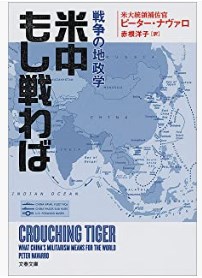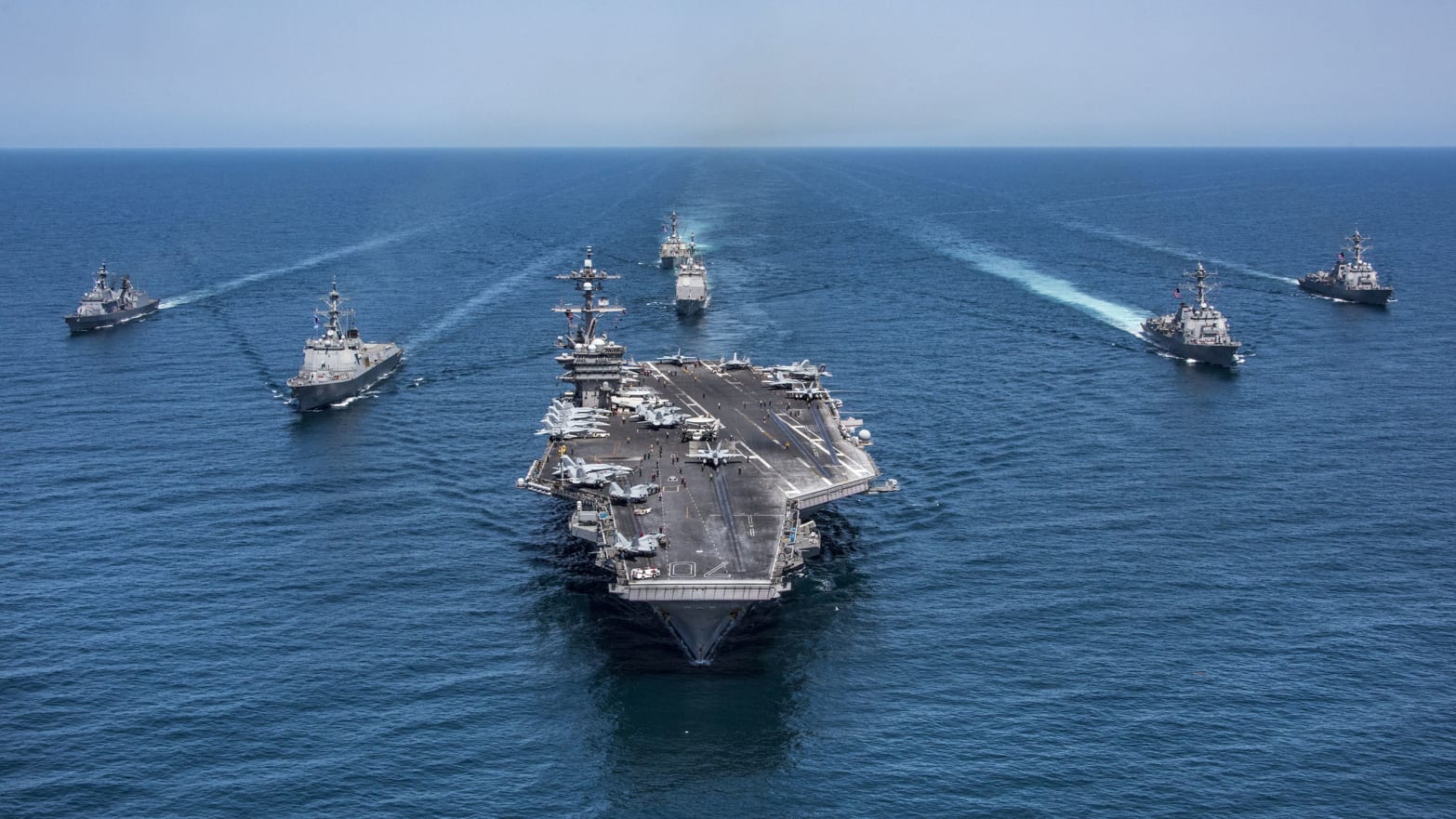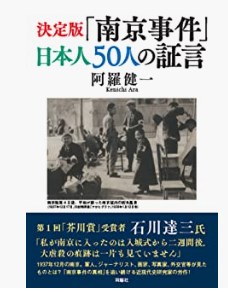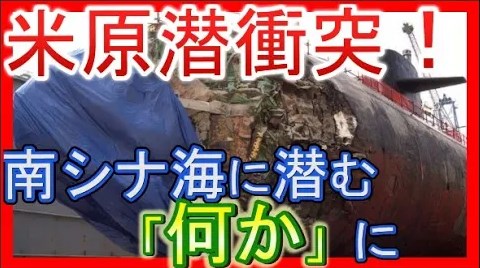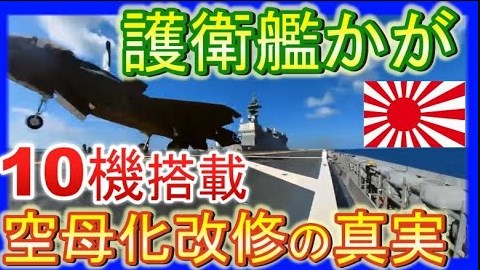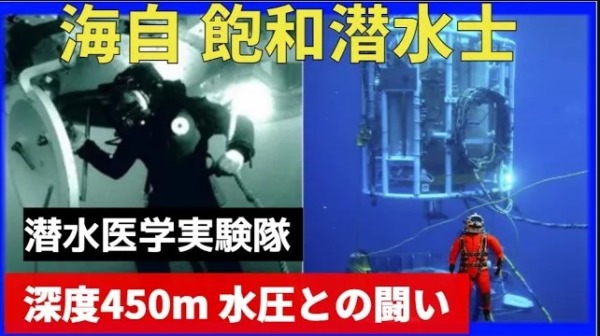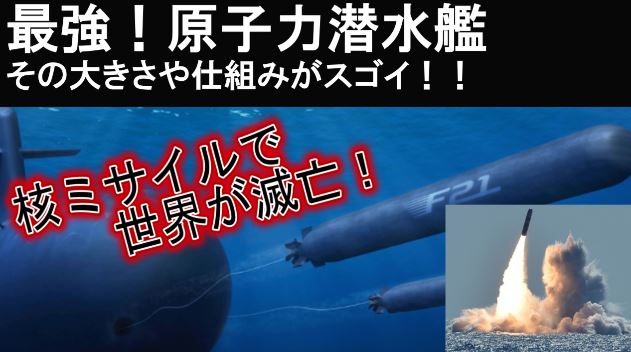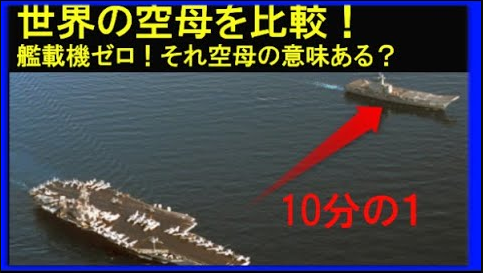
Amazonのオーディオブック12万タイトルの本を好きなだけお楽しみいただけます。・本の1冊分の月額で聴き放題
・料金をメリットが上回る
・いつでも読書できる
・読書量が格段に増え、積読が解消される
・長時間の読書も目が疲れない
・聴くたびに学びを感じる

This article is available in English.
Please scroll below the Japanese article to see the English version.
1920年12月16日、日本で初めて空母「鳳翔」(ほうしょう)が建造された。
それから100年がたった2020年現在、世界には21隻の空母が就役している。
そのうち 11 隻がアメリカ海軍所属の空母であり、ニミッツ級 10 隻、新型のフォード級1隻という内訳で、世界の空母の約半分がアメリカ海軍ということになる。
その中で最も古い空母が 1975年5月に就役した CVN-68 ニミッツで、艦齢はなんと45年にもなるが、現在も現役で活躍している。
サイズも世界最大で、全長333m 幅77m 満載排水量 10万トン以上という規格外のサイズだ。
海上自衛隊で最大の護衛艦は DDH「いずも」であるが、全長 248m 幅38m 満載排水量 26000トンなので、排水量で比較すると、なんと4倍近いサイズということになる。
ニミッツ級には乗員3270人、航空要員 2480人、司令部要員70名、合計で約6000人もの乗員が乗っている。

世界最強の空母部隊の動画も見てね♪
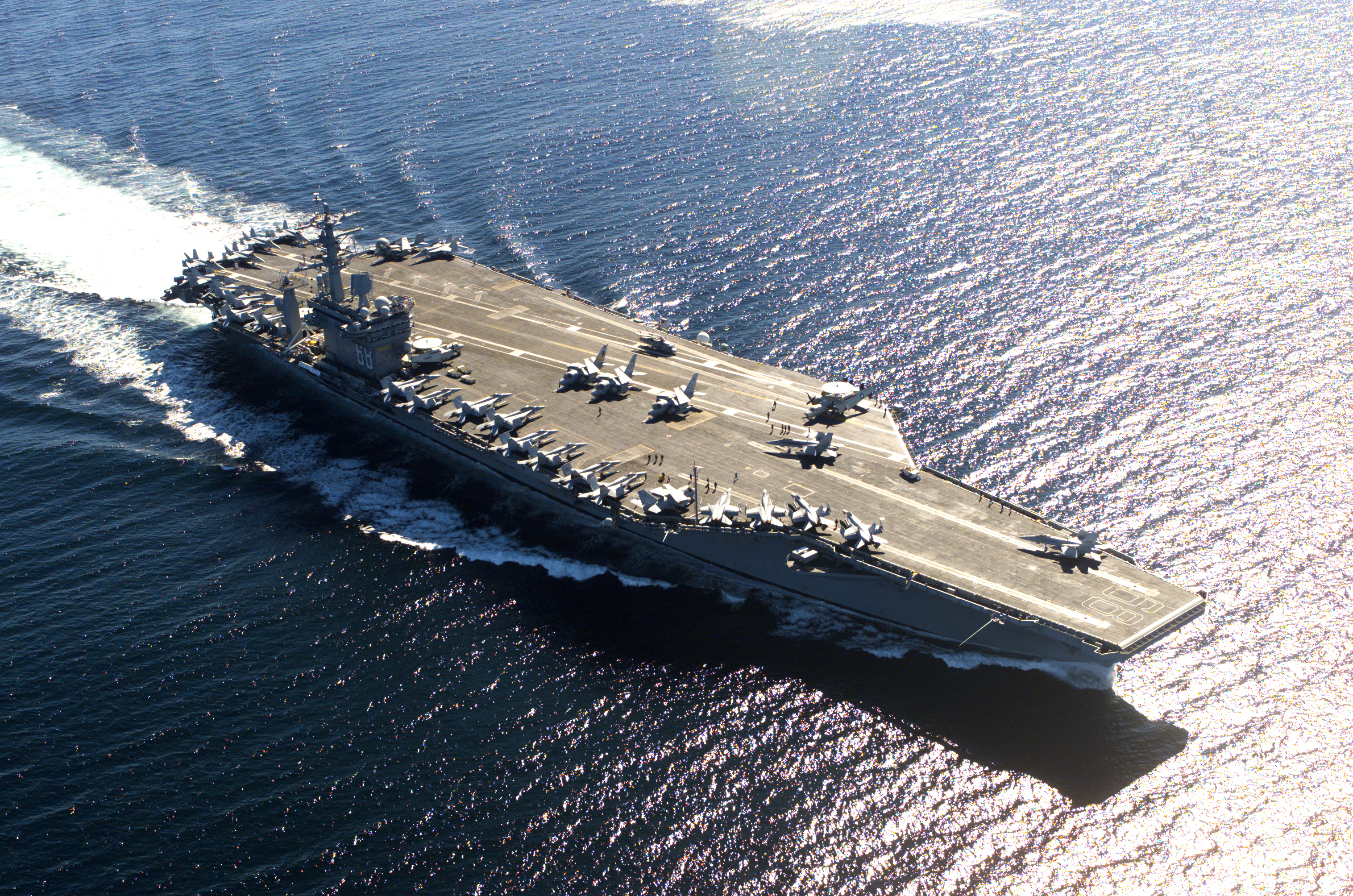
海上自衛隊の護衛艦は平均 200 人前後の乗員が乗っているので、なんと 30 隻分の乗員が1隻の空母に乗っている計算になる。
巨大な鉄の固まりである空母とは数多くの航空機を載せて、圧倒的な戦闘力で敵を撃滅するまさに「海上の要塞」だ。
アメリカ海軍は 11隻の原子力空母を保持しており、周りにはイージス艦、戦闘補給艦、原子力潜水艦をひきつれ、敵を一切寄せ付けない世界最強の艦隊として君臨している。
アメリカにとって、空母とは世界のどこにでも進出でき、強力な戦闘力をもって制圧できる安全保障上の要でもある。
今回は、世界最強の艦隊であるアメリカ海軍の空母打撃群について、その編成と任務に迫ってみた。
この記事に書かれている内容は
空母打撃群「キャリアストライクグループ」の編成とは?
空母は通常、単艦で行動することはほとんどない。
護衛として随判艦(ずいばんかん)と呼ばれる数隻の空母打撃群、通称 CSG(キャリアストライクグループ)とともに行動する。
空母を大統領に例えるなら、まわりの随判艦は大統領を護るための屈強な SP といえる。
空母打撃群の役割は、搭載する航空機により敵の陸上施設を破壊することが主であるが、そのためには空母の安全が確保されなければならない。
米海軍のホームページに記載されている、基本的な空母打撃群の編成は、次の通りである。
・空母×1
・ミサイル巡洋艦×1(イージス艦)
・ミサイル駆逐艦×2(イージス艦)
・攻撃型原子力潜水艦×1
・補給艦×1
タイコンデロガ級イージス艦1隻、アーレイバーク級イージス艦2隻、補給艦1隻、だけでなく、水中にもロサンゼルス級、ヴァージニア級、シーウルフ級といった原子力潜水艦がひっそりと随判しているのだ。
原子力潜水艦の役割は空母打撃群の遠方で敵潜水艦を撃沈することやトマホーク巡航ミサイルで敵陸上施設を破壊することが役目だ。
大名を取り囲む侍とは別に忍者が陰で守ってくれているようなイメージだ。
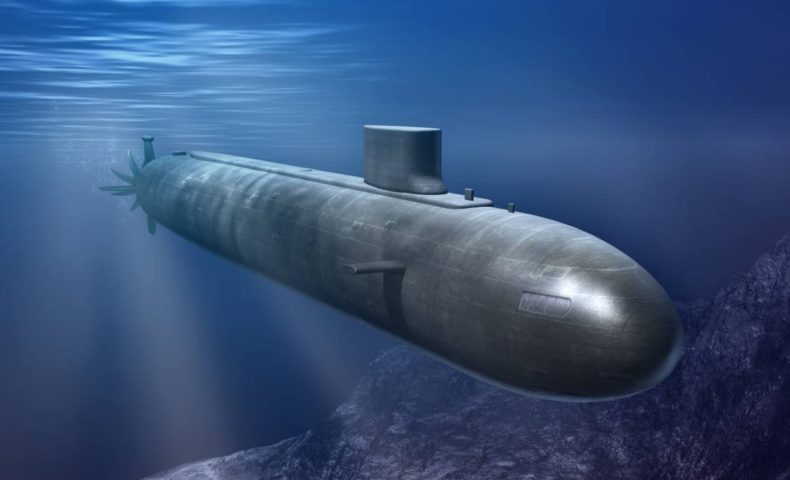
引用:https://grandfleet.info/
ただ、潜水艦から発射されるトマホークの音で空母の位置がばれてしまう恐れがあるため、実際は離れた位置で行動している可能性もある。
以前はロサンゼルス級原子力潜水艦がメインであり 62隻もの同型艦が建造されたが、近年は最新のヴァージニア級に変更されつつある。
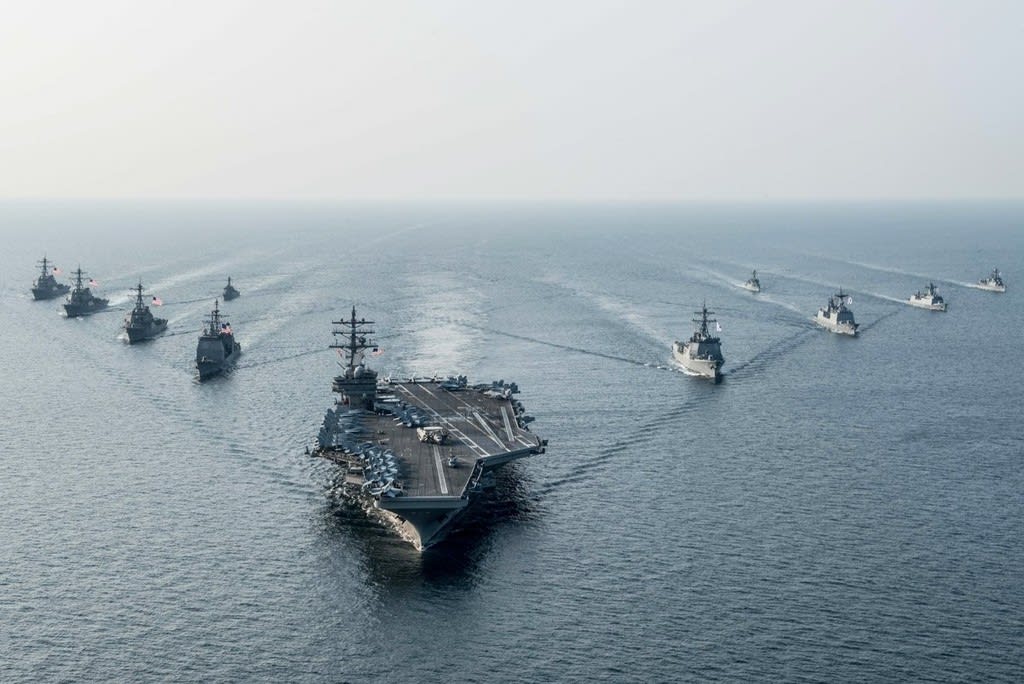
引用:https://blog.goo.ne.jp/sekiseikai_2007
訓練では巡洋艦や駆逐艦は1隻の場合もあるが、実戦となると 10隻以上を引き連れた大きなグループになることもある。
しかし、潜水艦の行動は極秘任務のため、実際に一緒に行動しているのか、またどのような任務を担っているのか詳細は明らかにされていない。
洋上のガソリンスタンド補給艦

戦闘艦艇のほかにも、重要な役割を果たすのが補給艦だ。
空母とともに行動する艦艇に燃料や水、食料、弾薬等を補給する大切な役目を担っている。
原子力空母の場合、動力元は原子力のため燃料補給は半永久的に不要であるが、その他の艦艇は燃料補給が必要となってくる。
補給艦を両方からはさむ形で走りながら、最大2隻の洋上補給が同時に可能となっている。
![DVIDS - Images - Ships assigned to Nimitz Carrie Strike Group Conduct RAS during COMPTUEX [Image 17 of 31]](https://cdn.dvidshub.net/media/thumbs/photos/1704/3314637/2000x1395_q95.jpg)
水や燃料は蛇管とよばれるパイプを直接つないで送ることになるが、食料などの物品はコンテナに乗せてワイヤーを伝って補給する。
艦艇同士がかなり近い距離まで近接し、同じ速力と針路で走る必要があり、高度な技術が要求される。
海が荒れているときは非常に危険な作業であることは間違いない。
補給艦は空母打撃群の任務達成のためにも必要不可欠な存在である。
空母の艦載機の任務とは?

空母には多くの艦載機が搭載されており、状況が切迫してくると航空機は最前線に飛び立ち、キャップステーションと呼ばれる、空中に設定されたポイントを旋回し、敵の進入を防ぐ役割を果たす。
空母に搭載された航空機こそが、もっとも重要な戦闘力であり、守るべきアセットなのだ。
その航空機は CAW(キャリアエアウイング)と呼ばれる空母航空集団にまとめられ、それぞれの空母とペアになって行動する。
搭載される航空機の種類は、敵を攻撃する戦闘機を主力とし、広いエリアで敵を探知できる早期警戒機、敵のレーダーや通信機器に妨害をかけることのできる電子戦機の他にも、輸送、連絡、偵察などを行う哨戒ヘリコプターなど混成航空部隊として編成され、どんな任務にも対応できるように編成されている。

空母打撃群のイージス艦の任務とは?
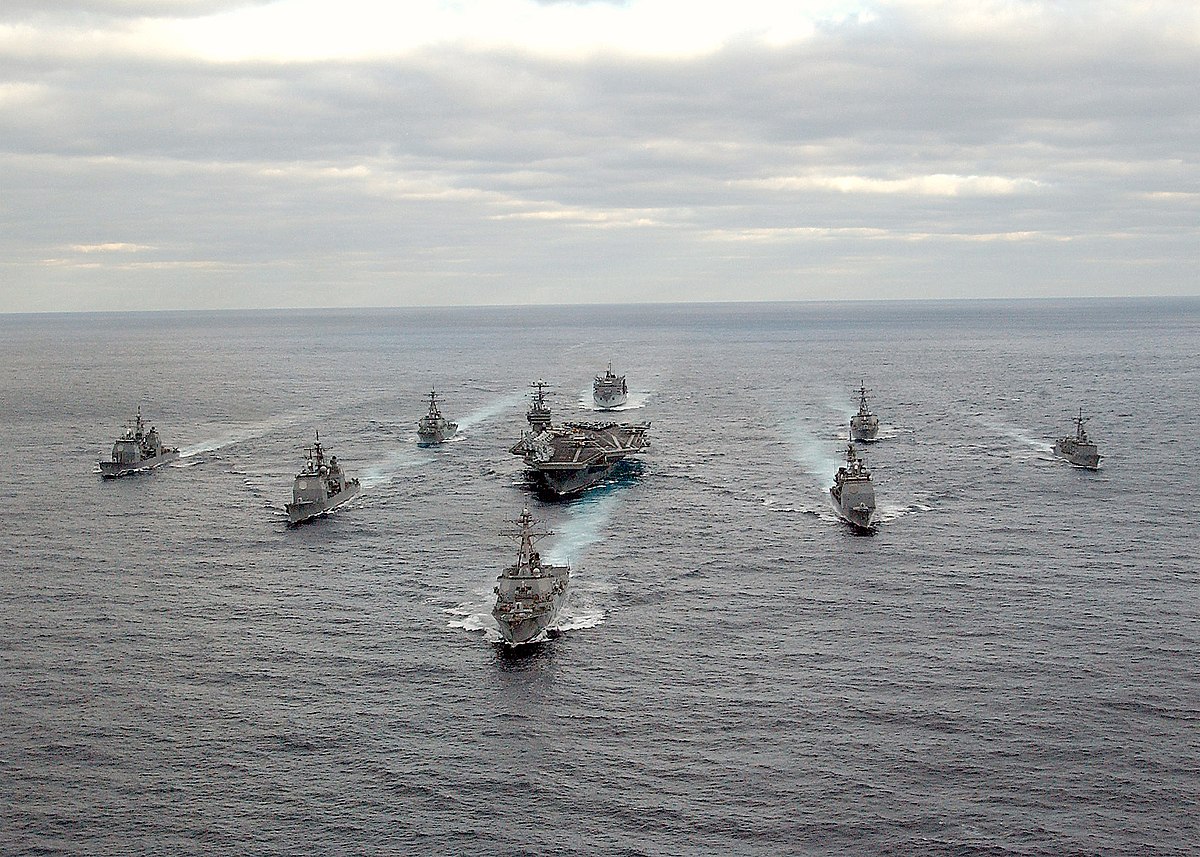
アメリカ海軍では、1980年代からイージスシステムを搭載しており、現在、空母打撃群に所属する艦艇はタイコンデロガ級巡洋艦とアーレイバーク級駆逐艦はすべてイージス艦となっている。
2種類のイージス艦の違いであるが、タイコンデロガ級イージスは空母の近くで直接護衛するのが目的だ。
![]()
イージス艦の目とも言われるSPY-1(スパイワン) レーダーの探知距離は半径 500km以上の能力があり、近づくミサイルや敵航空機を遠距離で探知し、対空ミサイルSM-2(エスエムツー)でこれを撃墜するのが主な任務だ。
また、タイコンデロガ級のもう1つの重要な任務が航空機の誘導である。
任務を終えた航空機は、母艦が送信するTACAN(タカン)と呼ばれる航法用の電波をキャッチして戻ってくる。
タカンは空母の位置を正確に知らせるための電波であるが、もしこの電波を敵から探知された場合、空母の位置がばれてしまい、ミサイル攻撃の対象になる恐れがある。
それを避けるために、作戦海域では空母の代わりにタイコンデロガ級がこの電波を出し、任務を終えた航空機は、それを頼りに戻ってくる。
[itemlink post_id=”1096″]
その後、空母からの航空管制の音声通信を受けて、無事に着艦することで、空母の位置を秘匿するための役割も担っている。
一方、アーレイバーク級イージス艦はシステム的にはタイコンデロガ級と似ているが、直接護衛よりも、離れた位置で行動することが多い。
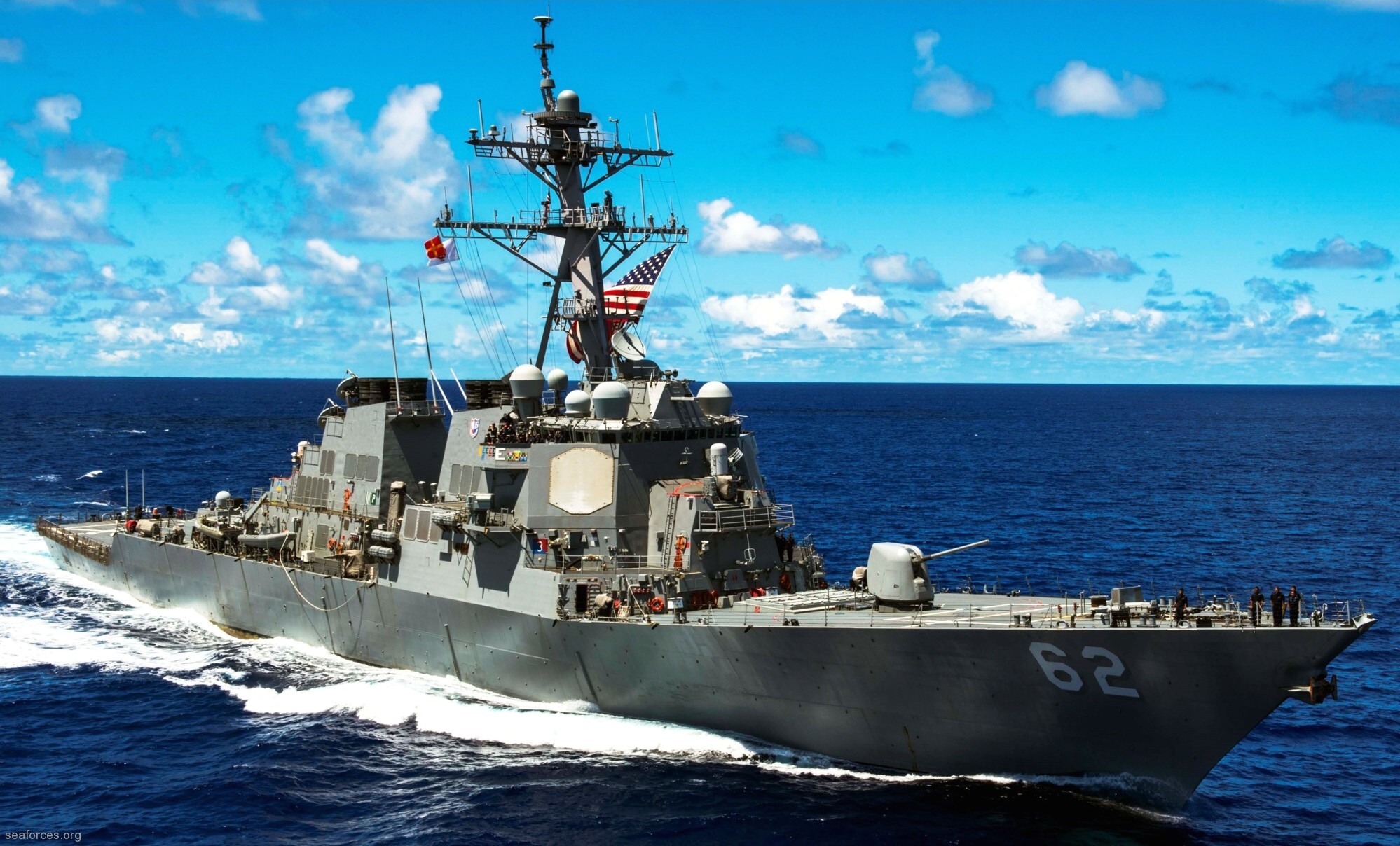
近づく潜水艦を遠距離で探知し、攻撃する役割のほか、搭載しているトマホーク巡航ミサイルにより、洋上から敵の陸上施設を破壊することも可能など、航空機に次いで、空母打撃群の重要な攻撃アセットとなっている。
最初に解説したように空母打撃群の編成は数隻からなるが、かつて冷戦末期から湾岸戦争のころは巡洋艦、駆逐艦、フリゲート、潜水艦、補給艦などかなりの大所帯であった。
当時、個艦防空能力しかない艦艇がほとんどで、艦隊全体守ることのできるイージス艦の数がまだ少なかったことが一番の理由だ。
空母(CVN) ×1
ミサイル巡洋艦(CG/CGN) X3
駆逐艦(DD)×2
フリゲイト×1
ミサイルフリゲイト(FFG)×1
攻撃型潜水艦(SSN)×2
補給艦(AOE) ×1
給兵艦(AE)×1 (弾薬補給艦)
しかし、近年はイージス艦の数もかなり増え、10 隻以下のグループになることがほとんどだ。
もう一つの理由が任務の多様化である。
北朝鮮の弾道ミサイル警戒や中国近海の「航行の自由作戦」などイージス艦を必要とする任務が増えてきている。
そのため空母打撃群から離れることが多くなったのだ。
空母による対象国へのプレゼンス
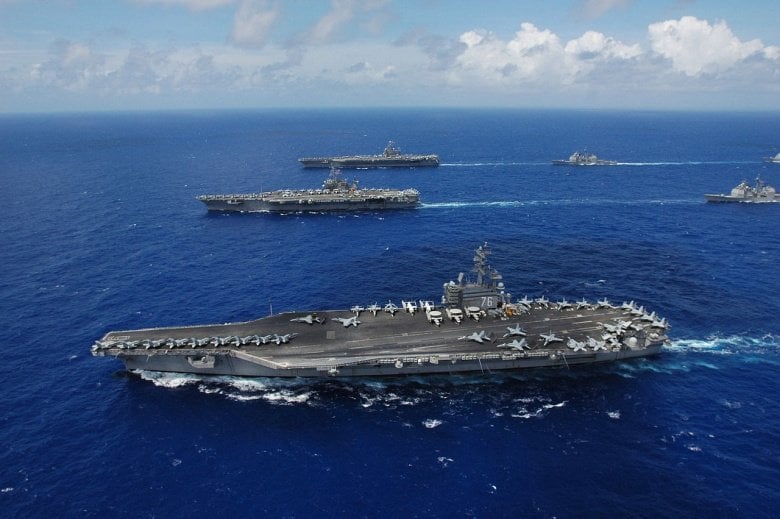
空母の位置はなるべく見つからないようにするのが作戦行動の基本ではあるが、逆にその存在をアピールすることが目的の場合もある
それがプレゼンスだ。
プレゼンスとは日本語で「けん制」とも言われ、対象国の挑発や不法な進出を抑制するために、その存在をあえてアピールすることが目的である。
空母が周辺国に寄港したり、大規模な合同演習を事前に公表したりするのは、対象国にその近海で活動していることを示すのが目的である。
しかし、近年は中国の軍事力が高まるにつれ、空母のプレゼンス効果が薄くなっているのも事実だ。
[itemlink post_id=”1098″]実際に中国はロシア海軍の空母を買い取ったのち大改装を行い、初の空母「遼寧」(りょうねい)を完成させ、日本近海で軍事演習を行っている。
現在は初の国産空母である山東(サントウ)と合わせて2隻の空母を保持しているが、アメリカ海軍に対抗するため、さらに2隻の建造が始まっている。
ただ、空母は建造して航空機を載せれば、それで終わりというわけではない。
実際の戦闘で使える航空機の運用はアメリカ海軍にはまだまだ及ばないであろう。
Strength of the US Carrier Strike Group! Equipped with 70 fighters! Strongest force in the World!
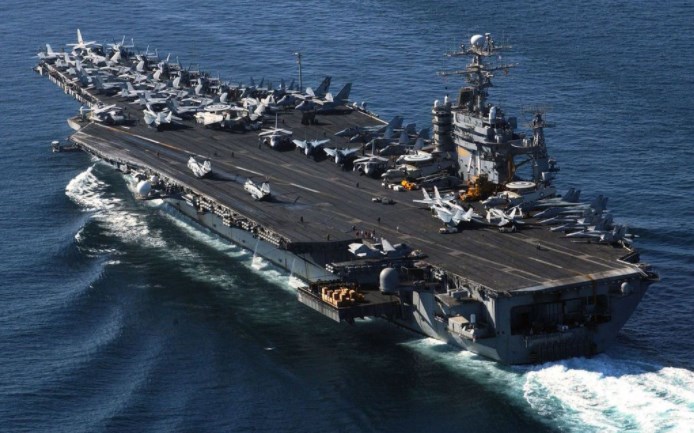
The oldest aircraft carrier is the CVN-68 Nimitz, which was commissioned in May 1975, and although she is 45 years old, she is still active.
She is also the largest in the world, with a total length of 333m, a width of 77m, and a displacement of 100,000 tons or more, which is a non-standard size.
The largest escort ship in the Japanese Maritime Self-Defense Force is the DDH “Izumo”, with a total length of 248m, a width of 38m, and a displacement of 26000 tons.
Comparing with only its displacement, it makes the Nimitz roughly 4 times larger.
The Nimitz class has 3,270 crew members, 2,480 aviation personnel, and 70 command personnel, for a total of about 6,000 crew members.
The Japanese Maritime Self-Defense Force’s escort ship has an average of about 200 crew members, so it is can be calculated that 30 times her 30 crew members are on one Nimitz aircraft carrier.
An aircraft carrier, which is a huge mass of iron, is just a “marine fortress” that carries a large number of aircraft and destroys enemies with overwhelming combat power.
The U.S. Navy holds her 11 nuclear-powered aircraft carriers, and is surrounded by Aegis ships, combat supply ships, and nuclear-powered submarines, reigning as the strongest fleet in the world that keeps enemies away.
For the United States, an aircraft carrier is also a security hub that can advance anywhere in the world and control it with powerful combat power.
In this video, I will explain the formation and mission of the Carrier Strike Group of the US Navy, which is the strongest fleet in the world.
What is the formation of the “Carrier Strike Group”?
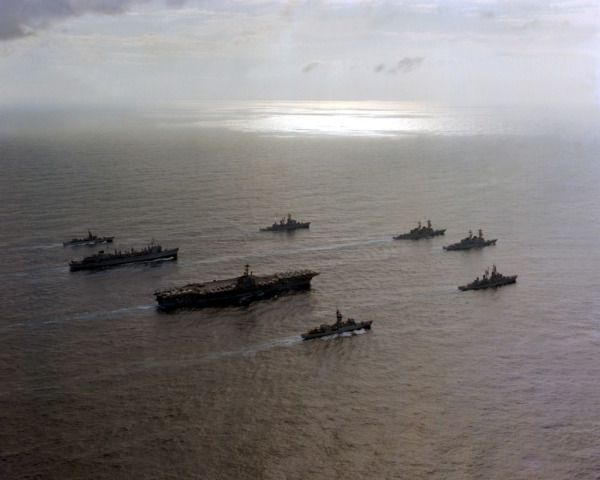
Aircraft carriers usually rarely act as a single ship.
As an escort, she acts with several Carrier Strike Groups called Zuibankan, commonly known as CSG.
If you compare an aircraft carrier to the president, you can say that the surrounding ships are strong bodyguards to protect the president.
The role of the carrier strike group is mainly to destroy the enemy’s land facilities by the aircraft on board, but for that purpose, the safety of the aircraft carrier must be ensured.
The basic carrier strike group organization described on the US Navy’s homepage is as follows.
Carrier strike group formation
・ Aircraft carrier x 1
・ Missile cruiser x 1 (Ticonderoga-class Aegis ship)
・ Missile destroyer x 2 (Arleigh Burke-class Aegis ships)
・ Attack type nuclear submarine x 1
・ Supply ship x 1
but also underwater nuclear submarines such as Los Angeles-class, Virginia-class, and Seawolf-class are quietly accompany it.
The role of nuclear submarines is to sink enemy submarines in the distance of carrier strike groups and to destroy enemy land facilities with Tomahawk cruise missiles.
It is like ninja protecting the daimyo from the shadows.
However, the sound of the tomahawk fired from the submarine may reveal the position of the aircraft carrier, so it is possible that it is actually acting from a distant position.
Previously, the Los Angeles-class nuclear submarine was the main, and her 62 ships of the same type were built, but in recent years it is being changed to the latest Virginia-class.
In training, she may have one cruiser or destroyer, but in combat she can be in a large group with more than ten.
However, since the submarine’s actions are confidential missions, it has not been clarified in detail whether they are actually acting together and what kind of mission they are in charge of.
Offshore gas station supply ship

In addition to combatants, supply ships also play an important role.
It plays an important role in supplying fuel, water, food, ammunition, etc. to ships that work with aircraft carriers.
In the case of a nuclear-powered aircraft carrier, refueling is not necessary semi-permanently because the power source is nuclear power, but other ships will need to be refueled.
It is possible to supply up to two ships at the same time while running with the supply ship sandwiched between them. Water and fuel are sent by directly connecting a pipe, but food and other items are placed in a container and carried along a wire.
Ships must be at a fairly short distance and run at the same speed and course, which requires advanced technology.
There is no doubt that it is a very dangerous task when the sea is rough.
The supply ship is also indispensable for accomplishing the mission of the carrier strike group.
What is the mission of a carrier-based aircraft?
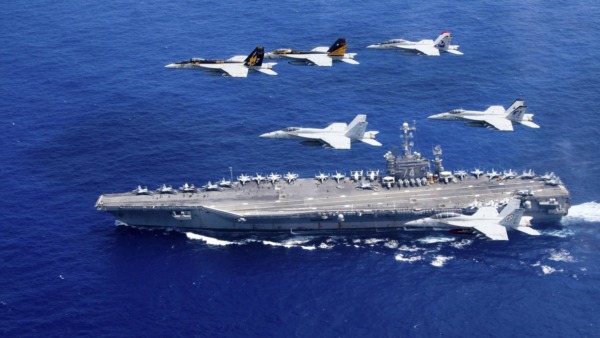
The aircraft carrier is equipped with many carrier-based aircraft, and when the situation is imminent, the aircraft takes off to the front line, and circles a point set in the air called a cap station, and plays a role of preventing the invasion of enemies.
The aircraft on board the aircraft carrier is the most important combat force and the asset to protect.
The aircraft are grouped into an aircraft carrier aviation group called CAW (Carrier Air Wing) and act in pairs with each aircraft carrier.
The types of aircraft to be installed are mainly fighter aircraft that attack the enemy, early warning aircraft that can detect the enemy in a wide area, electronic warfare aircraft that can interfere with the enemy’s radar and communication equipment, as well as transportation It is organized as a mixed aviation unit, such as a patrol helicopter that conducts contact, reconnaissance, etc., and is organized to handle any mission.
What is the mission of the Aegis ship carrier strike group?

The US Navy has been equipped with the Aegis system since the 1980s, and currently all ships belonging to the carrier strike group are Ticonderoga-class cruisers and Arleigh Burke-class destroyers.
The difference between the two types of Aegis ships is that the Ticonderoga-class Aegis ships is intended to be escorted directly near the aircraft carrier.
The SPY-1 radar, which is said to be the eye of an Aegis ship, has a radius of 500 km or more, and its main task is to detect approaching missiles and enemy aircraft at a long distance, and to shoot them down with the anti-aircraft missile SM-2.
Another important task of the Ticonderoga class is the guidance of aircraft.
After completing the mission, the aircraft catches the navigation radio waves called TACAN transmitted by the mother ship and returns.
TACAN is a radio wave that accurately informs the position of the aircraft carrier, but if this radio wave is detected by the enemy, the position of the aircraft carrier may be revealed and it may be the target of a missile attack.
In order to avoid this, the Ticonderoga class will emit this radio wave instead of the aircraft carrier in the operational sea area, and the aircraft that has completed the mission will return to rely on it.
After that, it also plays a role in concealing the position of the aircraft carrier by receiving the voice communication of air traffic control from the aircraft carrier for the aircraft to land safely.
Arleigh Burke-class Aegis ships, on the other hand, are systematically similar to the Ticonderoga-class, but often act farther away than direct escorts.
In addition to the role of detecting and attacking approaching submarines at a long distance, it is also possible to destroy enemy land facilities from the sea with the onboard Tomahawk cruise missile, which is an important attack asset of the carrier strike group next to the aircraft.
As explained at the beginning, the carrier strike group consists of several ships, but from the end of the Cold War to the Gulf War, it was a fairly large group of cruisers, destroyers, frigates, submarines, and supply ships.
At that time, most of the ships had only individual air defense capabilities, and the main reason was that the number of Aegis ships that could protect the entire fleet was still small.
Previous formation
Aircraft carrier (CVN) x 1
Missile Cruiser (CG / CGN) X3
Destroyer (DD) x 2
Frigate x 1
Missile frigate (FFG) x 1
Attack submarine (SSN) x 2
Supply ship (AOE) x 1
Warship (AE) x 1 (Ammunition Supply Ship)
However, in recent years, the number of Aegis ships has increased considerably, and most of them are in groups of 10 or less.
Another reason is the diversification of missions.
There are an increasing number of missions that require Aegis ships, such as North Korea’s ballistic missile alerts and “freedom of navigation operations” in the waters near China.
As a result, they often moved away from the carrier strike group.
Presence of aircraft carriers in target countries

The basic strategy is to try not be able to find the position of the aircraft carrier as much as possible, but on the contrary, there are cases where the purpose is to appeal its existence.
That is presence.
Presence is also called “control” in Japanese, and its purpose is to appeal its existence in order to suppress provocation and illegal advancement of the target country.
The purpose of aircraft carriers to call at neighboring countries and to announce large-scale joint exercises in advance is to show the target countries that they are active in the waters nearby.
However, it is also true that the presence effect of aircraft carriers has diminished in recent years as China’s military power has increased.
In fact, China has purchased the Russian Navy’s aircraft carrier and then undertook a major refurbishment to complete their first aircraft carrier, the Liaoning, and is conducting military exercises in the waters near Japan.
Currently, it holds two aircraft carriers, including the first domestic aircraft carrier Shandong, but construction of two more has begun to counter the US Navy.
However, if you build an aircraft carrier and put an aircraft on it, that is not the end.
The operation of aircraft that can be used in actual combat will still fall short of the US Navy.
Amazonのオーディオブック12万タイトルの本を好きなだけお楽しみいただけます。・本の1冊分の月額で聴き放題
・料金をメリットが上回る
・いつでも読書できる
・読書量が格段に増え、積読が解消される
・長時間の読書も目が疲れない
・聴くたびに学びを感じる
